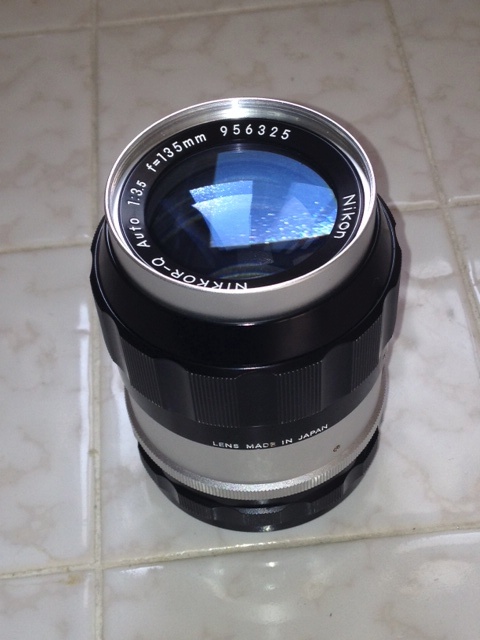Neither here nor there.

Blue, blue, blue. The mottling is from a mesh screen on the window, not in the lens.
Before the DSLR revolution the standard ‘3 lens’ outfit for the 35mm SLR snapper was comprised of 35, 50 and 135mm lenses. Today, with super range zoom lenses that is all yesterday’s news. In between, that outfit got shorter and wider, many opting for 28 or even 24mm at the wide end, 35mm as the ‘standard’ lens with 85-105mm at the long end. It’s not that there was anything inherently wrong with the 135mm focal length, it’s just that it was too long for portraits and too short to be really, well, long. But before they fell out of favor, Pentax, Minolta, Canon and Nikon made a boat load of 135s.
If serial numbers are any guide, Nikon alone made over 300,000 of the early 135mm f/3.5 design, their ‘budget’ model, comprised of but four lenses in three groups and made during the period June 1959 through March 1977. The first ones coincided with the release of the single greatest 35mm SLR in the history of the design, the Nikon F. And, indeed, my 1971 version not only remains budget priced – $65 near mint – but also comes with that exceptional build quality common to all Nikkors of the era, regardless of price. The same quality found in that Nikon F of yore.
A few minutes with a screwdriver and a flat file saw me confer the appropriate Ai relief on the rear of the aperture ring, which comes off easily once the five bayonet flange retaining screws are removed. Those less confident in their mechanical skills should send the lens to John White along with the modest fee asked. You really will hate getting this wrong. Another few minutes and overnight to let the epoxy cure saw a CPU installed.
Note the wild blue color of the single anti-reflection coating on the front element, something common to lenses of the period. No matter the color, it works well, though the lens benefits from a lens hood when used into the sun. Modern optics with multi-coating are more flare resistant. Then again, they don’t come along at $65, either ….
Preliminary snaps indicate a near total absence of vignetting or distortion at any aperture, with outstanding resolution fully open, peaking at f/8. But then that is to be expected from a beautifully simple Zeiss/Leitz optical design which goes back to the 1930s.The laws of physics do their thing at apertures smaller than f/11, where diffraction messes with light rays, but the optic is superb and highly recommended. The rendering of the out of focus bits is especially noteworthy, smooth and gentle. Balance on the Nikon D700 is well nigh perfect – a solid body and a no less compromised lens.
Lens correction profile::
Though in this case it’s pretty much overkill, the lens is that good, you can download the lens correction profile here. Maximum definition is reached at f/4.5 and maintained down to f/16. Distortion is negligible.
Some snaps from this lovely lens are coming soon. Look here.
I wonder what stuff from the current day will last a generation and be considered well- engineered 30 years from now.
I miss your commentary on mirrorless cameras. I’ve just been learning how to use the Olympus EM-5. The 12-50 zoom that I purchased with the camera works reasonably well and the 45mm f1.8 is superb. I bought the 100-300 mm Panasonic and have found that it is very slow focusing and the EVF of the Oly reacts slowly to the zoom at the top end. I long for some good fast telephoto lenses for the micro 4/3 systems, May investigate the old Canon lenses for use with an adapter.
Gary E
I picked up a 135mm/3,5 AI – i.e. the model subsequent to this. It makes a great and pocketable 200mm (effective) lens for APS-C bodies. It is a cracking lens with beautiful bokeh, great sharpness and marvellous colours and is mechanically tip top despite its age – it looks like it was never used by its previous owner. For 32€ (ebay) the best piece of equipment I ever bought. Highly recommended!